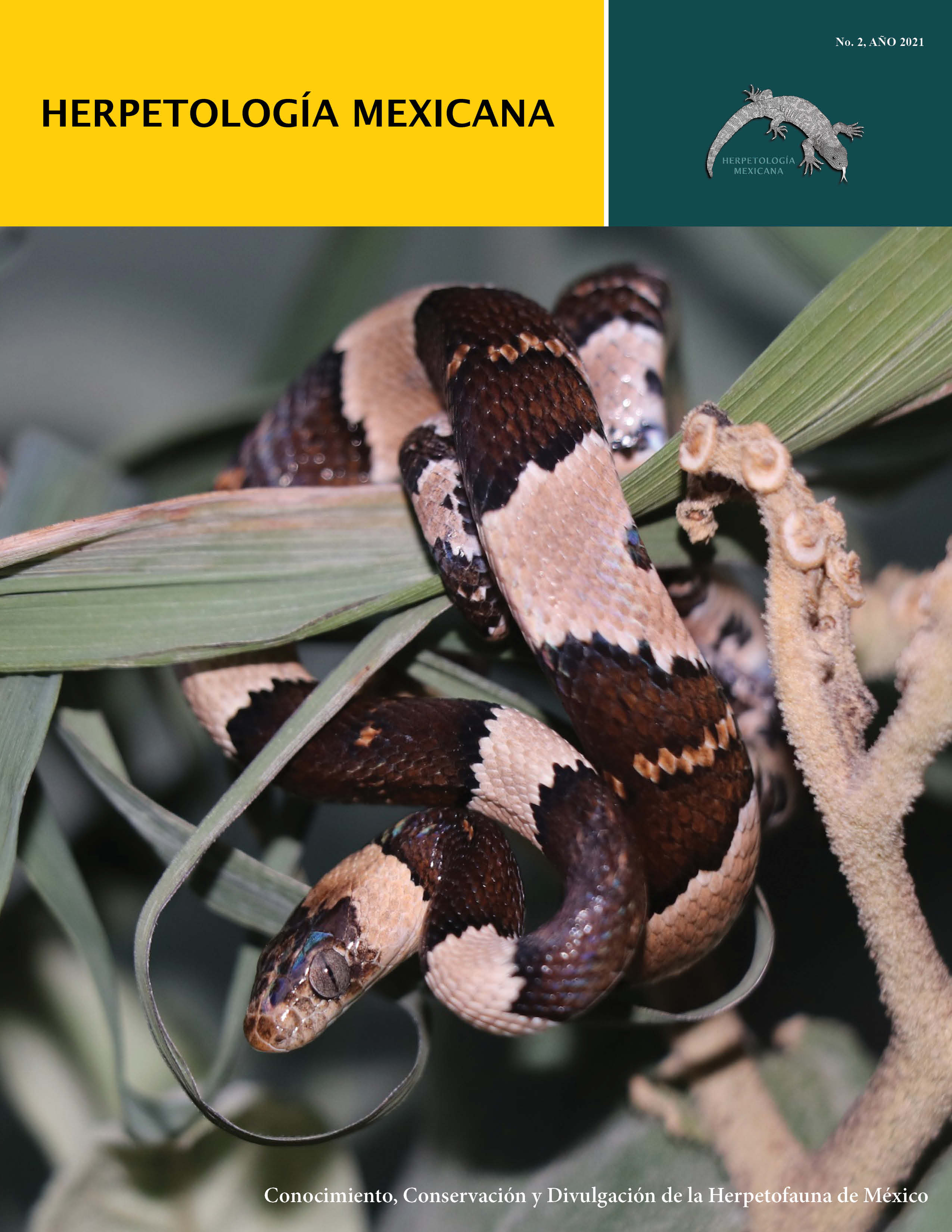Inventario de la herpetofauna de México 2021
DOI:
https://doi.org/10.69905/b6360e77Palabras clave:
Anfibios, Reptiles, Listado, MéxicoResumen
Se realizó una revisión de la información previa existente sobre los listados herpetofaunísticos y de las últimas publicaciones que describen nuevas especies para México. Con estos nuevos datos se presenta hasta la fecha el inventario de la herpetofauna de México en el cual registran un total de 1,389 especies nativas, de las cuales 420 son anfibios (291 endémicos) y 969 son reptiles (579 endémicos).
Referencias
Blackburn, D. C. & D. B Wake. 2011. Class Amphibia Gray, 182. In: Zhang, Z.-Q. (Ed.) Animal biodiversity: An outline of higher-level classification and survey of taxonomic richness. 3148: 39-55. Zootaxa.
Crother, B. I. (Ed.). 2017. Scientific and standard English names of amphibians and reptiles of North America north of Mexico, with comments regarding confidence in our understanding. 8th edition. SSAR Herpetological Circular, 43: 1-104.
Frost, D. R. 2021. Amphibian Species of the World: an Online Reference. Version 6.1 [Acceso: diciembre, 2021]. Electronic Database accessible at https://amphibiansoftheworld.amnh.org/index.php. American Museum of Natural History, New York, USA. doi.org/10.5531/db.vz.0001.
GBIF (Global Biodiversity Information Facility). www.gbif.org
Liner, E. A. 2007. A checklist of the Amphibians and Reptiles of Mexico. Occasional Paper of the Museum of Natural Science, Louisiana State University, 80: 1-60.
Liner, E. A. & G. Casas-Andreu. 2008. Standard spanish, english and scientific names of the Amphibians and Reptiles of Mexico. 2nd. Edition. Society for the Study of Amphibians and Reptiles. Herpetological Circular No. 38, 162 pp.
McCranie, J. R. 2018. The lizards, crocodiles, and turtles of Honduras. Systematics, distribution, and conservation. Bulletin of the Museum of Comparative Zoology, 15 (1): 1-130.
Pyron, R. A., F. T. Burbrink & J. J. Wiens. 2013. A phylogeny and revised classification of Squamata, including 4161 species of lizards and snakes. BMC Evolutionary Biology, 2013: 13-93.
Pyron, R. A. & V. Wallach. 2014. Systematics of the blindsnakes (Serpentes: Scolecophidia: Typhlopoidea) based on molecular & morphological evidence. Zootaxa, 3829 (1): 001-081.
Reséndiz-López M. A., O. Flores-Villela, L. Canseco-Márquez, D. Hernández-Robles, J. A. Lemos-Espinal. 2021. Lista de las especies de anfibios y reptiles con distribución en México. Version 1.1. Comisión Nacional para el Conocimiento y uso de la Biodiversidad. Checklist dataset. https://doi.org/10.15468/8cv47x. Acceso vía GBIF.org
Reynolds, R. G. & R. W. Henderson. 2018. Boas of the world (Superfamily Booidae): A Checklist with systematic, taxonomic, and conservation assessments. Bulletin of the Museum of Comparative Zoology, 162 (1): 1-59.
Rhodin, A. G. J., J. B. Iverson, R. Bour, U. Fritz, A. Georges, H. B. Shaffer & P. P. van Dijk. 2017. Turtles of the world: Annotated checklist and atlas of taxonomy, synonymy, distribution, and conservation status. In: Rhodin, A. G. J., J. B. Iverson, P, P. van Dijk, R. A. Saumure, K.A. Buhlmann, P. C. H. Pritchard & R. A. Mittermeier (Eds.). 7: 1-292. Conservation Biology of Freshwater Turtles and Tortoises: A Compilation Project of the IUCN/SSC Tortoise and Freshwater Turtle Specialist Group. Chelonian Research Monographs.
SEMARNAT (Secretaría de Medio Ambiente y Recursos Naturales). 2010. Norma Oficial Mexicana NOM-059. Proyecto de Modificación. Agosto 2018. México D. F., México. Diario Oficial de la Federación.
SNIB (Sistema Nacional de Información sobre Biodiversidad). https://www.snib.mx/
Shaffer, H. B., E. McCartney-Melstad, T. J. Near, G. G. Mount & P. Q. Spinks. 2017. Phylogenomic analyses of 539 highly informative loci dates a fully resolved time tree for the major clades of living turtles (Testudines). Molecular Phylogenetics and Evolution, 115 (2017): 7-15.
Uetz, P., P. Freed, R. Aguilar & J. Hošek (eds.). (2021) The Reptile Database. http://www.reptile-database.org, [Acceso: diciembre, 2021]
Wilson L. D., J. H. Townsend & J. D. Johnson (Eds.) 2010. Conservation of mesoamerican amphibians and reptiles. Eagle Mountain Publishing, LC. 812 pp.
Wilson L. D., J. D. Johnson & V. Mata-Silva. 2013a. A conservation reassessment of the amphibians of Mexico based on the EVS measure. Amphibian & Reptile Conservation, 7 (1): 97-127.
Wilson L. D., V. Mata-Silva & J. D. Johnson. 2013b. A conservation reassessment of the reptiles of Mexico based on the EVS measure. Amphibian & Reptile Conservation, 7 (1): 1-47.
Zaher H., R. W. Murphy, J. C. Arredondo, R. Graboski, P. R. Machado-Filho, K. Mahlow, G. G. Montingelli, A. Bottallo Quadros, N. L. Orlov, M. Wilkinson, Y-P. Zhang & F. G. Grazziotin. 2019. Large-scale molecular phylogeny, morphology, divergence-time estimation, and the fossil record of advanced caenophidian snakes (Squamata: Serpentes). PLoS ONE, 14 (5): e0216148. https://doi.org/10.1371/journal.pone.0216148.
Zheng, Y. & J. J. Wiens. 2016. Combining phylogenomic and supermatrix approaches and a timecalibrated phylogeny for squamate reptiles (lizards and snakes) based on 52 genes and 4162 species. Molecular Phylogenetics and Evolution, 94 (2016): 537-547.
Descargas
Publicado
Número
Sección
Licencia
Derechos de autor 2021 Carlos Jesús Balderas-Valdivia, Adriana González-Hernández (Autor/a)

Esta obra está bajo una licencia internacional Creative Commons Atribución-NoComercial-SinDerivadas 4.0.






